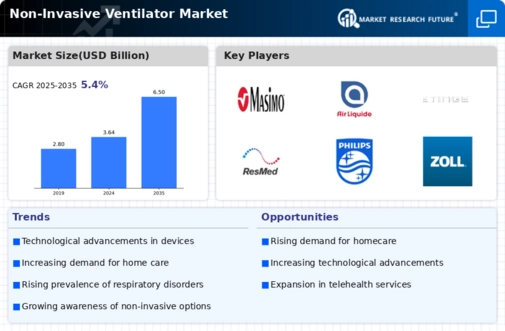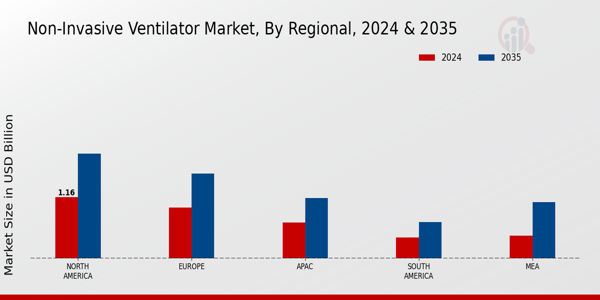-
EXECUTIVE SUMMARY
-
Market Overview
-
Key Findings
-
Market Segmentation
-
Competitive Landscape
-
Challenges and Opportunities
-
Future Outlook
-
MARKET INTRODUCTION
-
Definition
-
Scope of the study
- Research Objective
- Assumption
- Limitations
-
RESEARCH METHODOLOGY
-
Overview
-
Data Mining
-
Secondary Research
-
Primary Research
-
Primary Interviews and Information Gathering Process
-
Breakdown of Primary
-
Respondents
-
Forecasting Model
-
Market Size Estimation
-
Bottom-Up Approach
-
Top-Down Approach
-
Data Triangulation
-
Validation
-
MARKET DYNAMICS
-
Overview
-
Drivers
-
Restraints
-
Opportunities
-
MARKET FACTOR ANALYSIS
-
Value chain Analysis
-
Porter's Five Forces
-
Analysis
-
Bargaining Power of Suppliers
- Bargaining Power
-
of Buyers
-
Threat of New Entrants
- Threat of Substitutes
- Intensity of Rivalry
-
COVID-19 Impact Analysis
-
Market Impact Analysis
-
Regional Impact
- Opportunity and
-
Threat Analysis
-
NON-INVASIVE VENTILATOR MARKET, BY USAGE
-
TYPE (USD BILLION)
-
Portable
-
Stationary
-
Transportable
-
NON-INVASIVE VENTILATOR MARKET, BY APPLICATION (USD BILLION)
-
Chronic Obstructive Pulmonary Disease
-
Obstructive Sleep Apnea
-
Asthma
-
Pneumonia
-
NON-INVASIVE VENTILATOR MARKET, BY END USER
-
(USD BILLION)
-
Hospitals
-
Homecare
-
Ambulatory Surgical
-
Centers
-
NON-INVASIVE VENTILATOR MARKET, BY POWER SOURCE (USD BILLION)
-
Electric
-
Battery Powered
-
Hybrid
-
NON-INVASIVE
-
VENTILATOR MARKET, BY REGIONAL (USD BILLION)
-
North America
-
US
-
Canada
-
Europe
- Germany
- UK
- France
- Russia
- Italy
- Spain
- Rest of Europe
-
APAC
- China
-
India
-
Japan
- South Korea
- Malaysia
-
Thailand
-
Indonesia
- Rest of APAC
-
South America
- Brazil
- Mexico
- Argentina
-
Rest of South America
-
MEA
- GCC Countries
-
South Africa
-
Rest of MEA
-
COMPETITIVE LANDSCAPE
-
Overview
-
Competitive Analysis
-
Market share Analysis
-
Major Growth Strategy in the Non-Invasive Ventilator Market
-
Competitive Benchmarking
-
Leading Players in Terms of Number of Developments
-
in the Non-Invasive Ventilator Market
-
Key developments and growth strategies
- New Product Launch/Service Deployment
- Merger & Acquisitions
- Joint Ventures
-
Major Players Financial Matrix
-
Sales and Operating Income
-
Major Players R&D Expenditure. 2023
-
COMPANY PROFILES
-
GE Healthcare
- Financial Overview
- Products Offered
- Key Developments
- SWOT
-
Analysis
-
Key Strategies
-
Masimo
- Financial
-
Overview
-
Products Offered
- Key Developments
-
SWOT Analysis
-
Key Strategies
-
AirLiquide
-
Financial Overview
-
Products Offered
- Key Developments
- SWOT Analysis
- Key Strategies
-
Dräger
- Financial Overview
- Products Offered
- Key
-
Developments
-
SWOT Analysis
- Key Strategies
-
Getinge
-
Financial Overview
- Products Offered
-
Key Developments
-
SWOT Analysis
- Key Strategies
-
ResMed
-
Financial Overview
- Products Offered
-
Key Developments
-
SWOT Analysis
- Key Strategies
-
Fisher and Paykel Healthcare
-
Financial Overview
- Products
-
Offered
-
Key Developments
- SWOT Analysis
-
Key Strategies
-
Philips
- Financial Overview
-
Products Offered
-
Key Developments
- SWOT Analysis
- Key Strategies
-
Zoll Medical
- Financial Overview
- Products Offered
- Key Developments
- SWOT
-
Analysis
-
Key Strategies
-
BD
- Financial Overview
- Products Offered
- Key Developments
- SWOT
-
Analysis
-
Key Strategies
-
Nuvectra
- Financial
-
Overview
-
Products Offered
- Key Developments
-
SWOT Analysis
-
Key Strategies
-
Elekta
- Financial
-
Overview
-
Products Offered
- Key Developments
-
SWOT Analysis
-
Key Strategies
-
Smiths Medical
-
Financial Overview
-
Products Offered
- Key Developments
- SWOT Analysis
- Key Strategies
-
Medtronic
- Financial Overview
- Products Offered
-
Key Developments
-
SWOT Analysis
- Key Strategies
-
Linde
- Financial Overview
- Products Offered
- Key Developments
- SWOT Analysis
- Key
-
Strategies
-
APPENDIX
-
References
-
Related Reports
-
AMERICA NON-INVASIVE VENTILATOR MARKET SIZE ESTIMATES & FORECAST, BY USAGE TYPE,
-
2035 (USD BILLIONS)
-
SIZE ESTIMATES & FORECAST, BY APPLICATION, 2019-2035 (USD BILLIONS)
-
NORTH AMERICA NON-INVASIVE VENTILATOR MARKET SIZE ESTIMATES & FORECAST, BY
-
END USER, 2019-2035 (USD BILLIONS)
-
MARKET SIZE ESTIMATES & FORECAST, BY POWER SOURCE, 2019-2035 (USD BILLIONS)
-
FORECAST, BY REGIONAL, 2019-2035 (USD BILLIONS)
-
MARKET SIZE ESTIMATES & FORECAST, BY USAGE TYPE, 2019-2035 (USD BILLIONS)
-
2035 (USD BILLIONS)
-
& FORECAST, BY END USER, 2019-2035 (USD BILLIONS)
-
VENTILATOR MARKET SIZE ESTIMATES & FORECAST, BY POWER SOURCE, 2019-2035 (USD
-
BILLIONS)
-
FORECAST, BY REGIONAL, 2019-2035 (USD BILLIONS)
-
VENTILATOR MARKET SIZE ESTIMATES & FORECAST, BY USAGE TYPE, 2019-2035 (USD BILLIONS)
-
BY APPLICATION, 2019-2035 (USD BILLIONS)
-
MARKET SIZE ESTIMATES & FORECAST, BY END USER, 2019-2035 (USD BILLIONS)
-
BY POWER SOURCE, 2019-2035 (USD BILLIONS)
-
MARKET SIZE ESTIMATES & FORECAST, BY REGIONAL, 2019-2035 (USD BILLIONS)
-
BY USAGE TYPE, 2019-2035 (USD BILLIONS)
-
MARKET SIZE ESTIMATES & FORECAST, BY APPLICATION, 2019-2035 (USD BILLIONS)
-
BY END USER, 2019-2035 (USD BILLIONS)
-
MARKET SIZE ESTIMATES & FORECAST, BY POWER SOURCE, 2019-2035 (USD BILLIONS)
-
BY REGIONAL, 2019-2035 (USD BILLIONS)
-
MARKET SIZE ESTIMATES & FORECAST, BY USAGE TYPE, 2019-2035 (USD BILLIONS)
-
BY APPLICATION, 2019-2035 (USD BILLIONS)
-
MARKET SIZE ESTIMATES & FORECAST, BY END USER, 2019-2035 (USD BILLIONS)
-
BY POWER SOURCE, 2019-2035 (USD BILLIONS)
-
MARKET SIZE ESTIMATES & FORECAST, BY REGIONAL, 2019-2035 (USD BILLIONS)
-
USAGE TYPE, 2019-2035 (USD BILLIONS)
-
MARKET SIZE ESTIMATES & FORECAST, BY APPLICATION, 2019-2035 (USD BILLIONS)
-
END USER, 2019-2035 (USD BILLIONS)
-
SIZE ESTIMATES & FORECAST, BY POWER SOURCE, 2019-2035 (USD BILLIONS)
-
UK NON-INVASIVE VENTILATOR MARKET SIZE ESTIMATES & FORECAST, BY REGIONAL,
-
2035 (USD BILLIONS)
-
ESTIMATES & FORECAST, BY USAGE TYPE, 2019-2035 (USD BILLIONS)
-
FRANCE NON-INVASIVE VENTILATOR MARKET SIZE ESTIMATES & FORECAST, BY APPLICATION,
-
2035 (USD BILLIONS)
-
ESTIMATES & FORECAST, BY END USER, 2019-2035 (USD BILLIONS)
-
FRANCE NON-INVASIVE VENTILATOR MARKET SIZE ESTIMATES & FORECAST, BY POWER SOURCE,
-
2035 (USD BILLIONS)
-
ESTIMATES & FORECAST, BY REGIONAL, 2019-2035 (USD BILLIONS)
-
RUSSIA NON-INVASIVE VENTILATOR MARKET SIZE ESTIMATES & FORECAST, BY USAGE TYPE,
-
2035 (USD BILLIONS)
-
ESTIMATES & FORECAST, BY APPLICATION, 2019-2035 (USD BILLIONS)
-
RUSSIA NON-INVASIVE VENTILATOR MARKET SIZE ESTIMATES & FORECAST, BY END USER,
-
2035 (USD BILLIONS)
-
ESTIMATES & FORECAST, BY POWER SOURCE, 2019-2035 (USD BILLIONS)
-
RUSSIA NON-INVASIVE VENTILATOR MARKET SIZE ESTIMATES & FORECAST, BY REGIONAL,
-
2035 (USD BILLIONS)
-
ESTIMATES & FORECAST, BY USAGE TYPE, 2019-2035 (USD BILLIONS)
-
ITALY NON-INVASIVE VENTILATOR MARKET SIZE ESTIMATES & FORECAST, BY APPLICATION,
-
2035 (USD BILLIONS)
-
ESTIMATES & FORECAST, BY END USER, 2019-2035 (USD BILLIONS)
-
ITALY NON-INVASIVE VENTILATOR MARKET SIZE ESTIMATES & FORECAST, BY POWER SOURCE,
-
2035 (USD BILLIONS)
-
ESTIMATES & FORECAST, BY REGIONAL, 2019-2035 (USD BILLIONS)
-
SPAIN NON-INVASIVE VENTILATOR MARKET SIZE ESTIMATES & FORECAST, BY USAGE TYPE,
-
2035 (USD BILLIONS)
-
ESTIMATES & FORECAST, BY APPLICATION, 2019-2035 (USD BILLIONS)
-
SPAIN NON-INVASIVE VENTILATOR MARKET SIZE ESTIMATES & FORECAST, BY END USER,
-
2035 (USD BILLIONS)
-
ESTIMATES & FORECAST, BY POWER SOURCE, 2019-2035 (USD BILLIONS)
-
SPAIN NON-INVASIVE VENTILATOR MARKET SIZE ESTIMATES & FORECAST, BY REGIONAL,
-
2035 (USD BILLIONS)
-
MARKET SIZE ESTIMATES & FORECAST, BY USAGE TYPE, 2019-2035 (USD BILLIONS)
-
BY APPLICATION, 2019-2035 (USD BILLIONS)
-
VENTILATOR MARKET SIZE ESTIMATES & FORECAST, BY END USER, 2019-2035 (USD BILLIONS)
-
FORECAST, BY POWER SOURCE, 2019-2035 (USD BILLIONS)
-
NON-INVASIVE VENTILATOR MARKET SIZE ESTIMATES & FORECAST, BY REGIONAL, 2019-2035
-
(USD BILLIONS)
-
& FORECAST, BY USAGE TYPE, 2019-2035 (USD BILLIONS)
-
VENTILATOR MARKET SIZE ESTIMATES & FORECAST, BY APPLICATION, 2019-2035 (USD
-
BILLIONS)
-
FORECAST, BY END USER, 2019-2035 (USD BILLIONS)
-
VENTILATOR MARKET SIZE ESTIMATES & FORECAST, BY POWER SOURCE, 2019-2035 (USD
-
BILLIONS)
-
FORECAST, BY REGIONAL, 2019-2035 (USD BILLIONS)
-
VENTILATOR MARKET SIZE ESTIMATES & FORECAST, BY USAGE TYPE, 2019-2035 (USD BILLIONS)
-
BY APPLICATION, 2019-2035 (USD BILLIONS)
-
MARKET SIZE ESTIMATES & FORECAST, BY END USER, 2019-2035 (USD BILLIONS)
-
BY POWER SOURCE, 2019-2035 (USD BILLIONS)
-
MARKET SIZE ESTIMATES & FORECAST, BY REGIONAL, 2019-2035 (USD BILLIONS)
-
BY USAGE TYPE, 2019-2035 (USD BILLIONS)
-
MARKET SIZE ESTIMATES & FORECAST, BY APPLICATION, 2019-2035 (USD BILLIONS)
-
BY END USER, 2019-2035 (USD BILLIONS)
-
MARKET SIZE ESTIMATES & FORECAST, BY POWER SOURCE, 2019-2035 (USD BILLIONS)
-
BY REGIONAL, 2019-2035 (USD BILLIONS)
-
MARKET SIZE ESTIMATES & FORECAST, BY USAGE TYPE, 2019-2035 (USD BILLIONS)
-
BY APPLICATION, 2019-2035 (USD BILLIONS)
-
MARKET SIZE ESTIMATES & FORECAST, BY END USER, 2019-2035 (USD BILLIONS)
-
BY POWER SOURCE, 2019-2035 (USD BILLIONS)
-
MARKET SIZE ESTIMATES & FORECAST, BY REGIONAL, 2019-2035 (USD BILLIONS)
-
BY USAGE TYPE, 2019-2035 (USD BILLIONS)
-
VENTILATOR MARKET SIZE ESTIMATES & FORECAST, BY APPLICATION, 2019-2035 (USD
-
BILLIONS)
-
& FORECAST, BY END USER, 2019-2035 (USD BILLIONS)
-
NON-INVASIVE VENTILATOR MARKET SIZE ESTIMATES & FORECAST, BY POWER SOURCE, 2019-2035
-
(USD BILLIONS)
-
& FORECAST, BY REGIONAL, 2019-2035 (USD BILLIONS)
-
VENTILATOR MARKET SIZE ESTIMATES & FORECAST, BY USAGE TYPE, 2019-2035 (USD BILLIONS)
-
BY APPLICATION, 2019-2035 (USD BILLIONS)
-
MARKET SIZE ESTIMATES & FORECAST, BY END USER, 2019-2035 (USD BILLIONS)
-
BY POWER SOURCE, 2019-2035 (USD BILLIONS)
-
VENTILATOR MARKET SIZE ESTIMATES & FORECAST, BY REGIONAL, 2019-2035 (USD BILLIONS)
-
BY USAGE TYPE, 2019-2035 (USD BILLIONS)
-
MARKET SIZE ESTIMATES & FORECAST, BY APPLICATION, 2019-2035 (USD BILLIONS)
-
BY END USER, 2019-2035 (USD BILLIONS)
-
MARKET SIZE ESTIMATES & FORECAST, BY POWER SOURCE, 2019-2035 (USD BILLIONS)
-
BY REGIONAL, 2019-2035 (USD BILLIONS)
-
MARKET SIZE ESTIMATES & FORECAST, BY USAGE TYPE, 2019-2035 (USD BILLIONS)
-
BY APPLICATION, 2019-2035 (USD BILLIONS)
-
VENTILATOR MARKET SIZE ESTIMATES & FORECAST, BY END USER, 2019-2035 (USD BILLIONS)
-
BY POWER SOURCE, 2019-2035 (USD BILLIONS)
-
VENTILATOR MARKET SIZE ESTIMATES & FORECAST, BY REGIONAL, 2019-2035 (USD BILLIONS)
-
FORECAST, BY USAGE TYPE, 2019-2035 (USD BILLIONS)
-
VENTILATOR MARKET SIZE ESTIMATES & FORECAST, BY APPLICATION, 2019-2035 (USD
-
BILLIONS)
-
& FORECAST, BY END USER, 2019-2035 (USD BILLIONS)
-
NON-INVASIVE VENTILATOR MARKET SIZE ESTIMATES & FORECAST, BY POWER SOURCE, 2019-2035
-
(USD BILLIONS)
-
ESTIMATES & FORECAST, BY REGIONAL, 2019-2035 (USD BILLIONS)
-
SOUTH AMERICA NON-INVASIVE VENTILATOR MARKET SIZE ESTIMATES & FORECAST, BY USAGE
-
TYPE, 2019-2035 (USD BILLIONS)
-
MARKET SIZE ESTIMATES & FORECAST, BY APPLICATION, 2019-2035 (USD BILLIONS)
-
BY END USER, 2019-2035 (USD BILLIONS)
-
VENTILATOR MARKET SIZE ESTIMATES & FORECAST, BY POWER SOURCE, 2019-2035 (USD
-
BILLIONS)
-
& FORECAST, BY REGIONAL, 2019-2035 (USD BILLIONS)
-
VENTILATOR MARKET SIZE ESTIMATES & FORECAST, BY USAGE TYPE, 2019-2035 (USD BILLIONS)
-
BY APPLICATION, 2019-2035 (USD BILLIONS)
-
MARKET SIZE ESTIMATES & FORECAST, BY END USER, 2019-2035 (USD BILLIONS)
-
BY POWER SOURCE, 2019-2035 (USD BILLIONS)
-
MARKET SIZE ESTIMATES & FORECAST, BY REGIONAL, 2019-2035 (USD BILLIONS)
-
BY USAGE TYPE, 2019-2035 (USD BILLIONS)
-
MARKET SIZE ESTIMATES & FORECAST, BY APPLICATION, 2019-2035 (USD BILLIONS)
-
BY END USER, 2019-2035 (USD BILLIONS)
-
MARKET SIZE ESTIMATES & FORECAST, BY POWER SOURCE, 2019-2035 (USD BILLIONS)
-
BY REGIONAL, 2019-2035 (USD BILLIONS)
-
MARKET SIZE ESTIMATES & FORECAST, BY USAGE TYPE, 2019-2035 (USD BILLIONS)
-
BY APPLICATION, 2019-2035 (USD BILLIONS)
-
VENTILATOR MARKET SIZE ESTIMATES & FORECAST, BY END USER, 2019-2035 (USD BILLIONS)
-
BY POWER SOURCE, 2019-2035 (USD BILLIONS)
-
VENTILATOR MARKET SIZE ESTIMATES & FORECAST, BY REGIONAL, 2019-2035 (USD BILLIONS)
-
& FORECAST, BY USAGE TYPE, 2019-2035 (USD BILLIONS)
-
SOUTH AMERICA NON-INVASIVE VENTILATOR MARKET SIZE ESTIMATES & FORECAST, BY APPLICATION,
-
2035 (USD BILLIONS)
-
MARKET SIZE ESTIMATES & FORECAST, BY END USER, 2019-2035 (USD BILLIONS)
-
& FORECAST, BY POWER SOURCE, 2019-2035 (USD BILLIONS)
-
OF SOUTH AMERICA NON-INVASIVE VENTILATOR MARKET SIZE ESTIMATES & FORECAST, BY
-
REGIONAL, 2019-2035 (USD BILLIONS)
-
MARKET SIZE ESTIMATES & FORECAST, BY USAGE TYPE, 2019-2035 (USD BILLIONS)
-
APPLICATION, 2019-2035 (USD BILLIONS)
-
MARKET SIZE ESTIMATES & FORECAST, BY END USER, 2019-2035 (USD BILLIONS)
-
POWER SOURCE, 2019-2035 (USD BILLIONS)
-
MARKET SIZE ESTIMATES & FORECAST, BY REGIONAL, 2019-2035 (USD BILLIONS)
-
BY USAGE TYPE, 2019-2035 (USD BILLIONS)
-
VENTILATOR MARKET SIZE ESTIMATES & FORECAST, BY APPLICATION, 2019-2035 (USD
-
BILLIONS)
-
& FORECAST, BY END USER, 2019-2035 (USD BILLIONS)
-
NON-INVASIVE VENTILATOR MARKET SIZE ESTIMATES & FORECAST, BY POWER SOURCE, 2019-2035
-
(USD BILLIONS)
-
ESTIMATES & FORECAST, BY REGIONAL, 2019-2035 (USD BILLIONS)
-
SOUTH AFRICA NON-INVASIVE VENTILATOR MARKET SIZE ESTIMATES & FORECAST, BY USAGE
-
TYPE, 2019-2035 (USD BILLIONS)
-
MARKET SIZE ESTIMATES & FORECAST, BY APPLICATION, 2019-2035 (USD BILLIONS)
-
BY END USER, 2019-2035 (USD BILLIONS)
-
VENTILATOR MARKET SIZE ESTIMATES & FORECAST, BY POWER SOURCE, 2019-2035 (USD
-
BILLIONS)
-
& FORECAST, BY REGIONAL, 2019-2035 (USD BILLIONS)
-
NON-INVASIVE VENTILATOR MARKET SIZE ESTIMATES & FORECAST, BY USAGE TYPE, 2019-2035
-
(USD BILLIONS)
-
ESTIMATES & FORECAST, BY APPLICATION, 2019-2035 (USD BILLIONS)
-
REST OF MEA NON-INVASIVE VENTILATOR MARKET SIZE ESTIMATES & FORECAST, BY END
-
USER, 2019-2035 (USD BILLIONS)
-
MARKET SIZE ESTIMATES & FORECAST, BY POWER SOURCE, 2019-2035 (USD BILLIONS)
-
FORECAST, BY REGIONAL, 2019-2035 (USD BILLIONS)
-
DEVELOPMENT/APPROVAL
-
VENTILATOR MARKET ANALYSIS
-
BY USAGE TYPE
-
US NON-INVASIVE VENTILATOR MARKET ANALYSIS BY POWER SOURCE
-
NON-INVASIVE VENTILATOR MARKET ANALYSIS BY REGIONAL
-
VENTILATOR MARKET ANALYSIS BY USAGE TYPE
-
MARKET ANALYSIS BY APPLICATION
-
ANALYSIS BY END USER
-
BY POWER SOURCE
-
BY REGIONAL
-
GERMANY NON-INVASIVE VENTILATOR MARKET ANALYSIS BY APPLICATION
-
GERMANY NON-INVASIVE VENTILATOR MARKET ANALYSIS BY END USER
-
GERMANY NON-INVASIVE VENTILATOR MARKET ANALYSIS BY POWER SOURCE
-
GERMANY NON-INVASIVE VENTILATOR MARKET ANALYSIS BY REGIONAL
-
NON-INVASIVE VENTILATOR MARKET ANALYSIS BY USAGE TYPE
-
VENTILATOR MARKET ANALYSIS BY APPLICATION
-
MARKET ANALYSIS BY END USER
-
BY POWER SOURCE
-
FRANCE NON-INVASIVE VENTILATOR MARKET ANALYSIS BY END USER
-
FRANCE NON-INVASIVE VENTILATOR MARKET ANALYSIS BY POWER SOURCE
-
FRANCE NON-INVASIVE VENTILATOR MARKET ANALYSIS BY REGIONAL
-
NON-INVASIVE VENTILATOR MARKET ANALYSIS BY USAGE TYPE
-
VENTILATOR MARKET ANALYSIS BY APPLICATION
-
MARKET ANALYSIS BY END USER
-
ANALYSIS BY POWER SOURCE
-
ANALYSIS BY REGIONAL
-
BY USAGE TYPE
-
APPLICATION
-
USER
-
SPAIN NON-INVASIVE VENTILATOR MARKET ANALYSIS BY USAGE TYPE
-
SPAIN NON-INVASIVE VENTILATOR MARKET ANALYSIS BY APPLICATION
-
NON-INVASIVE VENTILATOR MARKET ANALYSIS BY END USER
-
VENTILATOR MARKET ANALYSIS BY POWER SOURCE
-
MARKET ANALYSIS BY REGIONAL
-
MARKET ANALYSIS BY USAGE TYPE
-
MARKET ANALYSIS BY APPLICATION
-
MARKET ANALYSIS BY END USER
-
MARKET ANALYSIS BY POWER SOURCE
-
MARKET ANALYSIS BY REGIONAL
-
ANALYSIS
-
TYPE
-
CHINA NON-INVASIVE VENTILATOR MARKET ANALYSIS BY POWER SOURCE
-
CHINA NON-INVASIVE VENTILATOR MARKET ANALYSIS BY REGIONAL
-
NON-INVASIVE VENTILATOR MARKET ANALYSIS BY USAGE TYPE
-
VENTILATOR MARKET ANALYSIS BY APPLICATION
-
MARKET ANALYSIS BY END USER
-
ANALYSIS BY POWER SOURCE
-
BY REGIONAL
-
TYPE
-
JAPAN NON-INVASIVE VENTILATOR MARKET ANALYSIS BY POWER SOURCE
-
JAPAN NON-INVASIVE VENTILATOR MARKET ANALYSIS BY REGIONAL
-
KOREA NON-INVASIVE VENTILATOR MARKET ANALYSIS BY USAGE TYPE
-
KOREA NON-INVASIVE VENTILATOR MARKET ANALYSIS BY APPLICATION
-
KOREA NON-INVASIVE VENTILATOR MARKET ANALYSIS BY END USER
-
KOREA NON-INVASIVE VENTILATOR MARKET ANALYSIS BY POWER SOURCE
-
KOREA NON-INVASIVE VENTILATOR MARKET ANALYSIS BY REGIONAL
-
NON-INVASIVE VENTILATOR MARKET ANALYSIS BY USAGE TYPE
-
NON-INVASIVE VENTILATOR MARKET ANALYSIS BY APPLICATION
-
NON-INVASIVE VENTILATOR MARKET ANALYSIS BY END USER
-
VENTILATOR MARKET ANALYSIS BY POWER SOURCE
-
VENTILATOR MARKET ANALYSIS BY REGIONAL
-
MARKET ANALYSIS BY USAGE TYPE
-
MARKET ANALYSIS BY APPLICATION
-
MARKET ANALYSIS BY END USER
-
ANALYSIS BY POWER SOURCE
-
ANALYSIS BY REGIONAL
-
BY USAGE TYPE
-
BY APPLICATION
-
BY END USER
-
POWER SOURCE
-
BY REGIONAL
-
BY USAGE TYPE
-
BY APPLICATION
-
BY END USER
-
BY POWER SOURCE
-
BY REGIONAL
-
BRAZIL NON-INVASIVE VENTILATOR MARKET ANALYSIS BY END USER
-
BRAZIL NON-INVASIVE VENTILATOR MARKET ANALYSIS BY POWER SOURCE
-
BRAZIL NON-INVASIVE VENTILATOR MARKET ANALYSIS BY REGIONAL
-
NON-INVASIVE VENTILATOR MARKET ANALYSIS BY USAGE TYPE
-
VENTILATOR MARKET ANALYSIS BY APPLICATION
-
MARKET ANALYSIS BY END USER
-
ANALYSIS BY POWER SOURCE
-
ANALYSIS BY REGIONAL
-
ANALYSIS BY USAGE TYPE
-
ANALYSIS BY APPLICATION
-
ANALYSIS BY END USER
-
ANALYSIS BY POWER SOURCE
-
ANALYSIS BY REGIONAL
-
MARKET ANALYSIS BY USAGE TYPE
-
VENTILATOR MARKET ANALYSIS BY APPLICATION
-
NON-INVASIVE VENTILATOR MARKET ANALYSIS BY END USER
-
AMERICA NON-INVASIVE VENTILATOR MARKET ANALYSIS BY POWER SOURCE
-
REST OF SOUTH AMERICA NON-INVASIVE VENTILATOR MARKET ANALYSIS BY REGIONAL
-
MEA NON-INVASIVE VENTILATOR MARKET ANALYSIS
-
NON-INVASIVE VENTILATOR MARKET ANALYSIS BY USAGE TYPE
-
NON-INVASIVE VENTILATOR MARKET ANALYSIS BY APPLICATION
-
NON-INVASIVE VENTILATOR MARKET ANALYSIS BY END USER
-
NON-INVASIVE VENTILATOR MARKET ANALYSIS BY POWER SOURCE
-
NON-INVASIVE VENTILATOR MARKET ANALYSIS BY REGIONAL
-
NON-INVASIVE VENTILATOR MARKET ANALYSIS BY USAGE TYPE
-
NON-INVASIVE VENTILATOR MARKET ANALYSIS BY APPLICATION
-
NON-INVASIVE VENTILATOR MARKET ANALYSIS BY END USER
-
NON-INVASIVE VENTILATOR MARKET ANALYSIS BY POWER SOURCE
-
AFRICA NON-INVASIVE VENTILATOR MARKET ANALYSIS BY REGIONAL
-
OF MEA NON-INVASIVE VENTILATOR MARKET ANALYSIS BY USAGE TYPE
-
OF MEA NON-INVASIVE VENTILATOR MARKET ANALYSIS BY APPLICATION
-
REST OF MEA NON-INVASIVE VENTILATOR MARKET ANALYSIS BY END USER
-
REST OF MEA NON-INVASIVE VENTILATOR MARKET ANALYSIS BY POWER SOURCE
-
REST OF MEA NON-INVASIVE VENTILATOR MARKET ANALYSIS BY REGIONAL
-
KEY BUYING CRITERIA OF NON-INVASIVE VENTILATOR MARKET
-
PROCESS OF MRFR
-
RESTRAINTS IMPACT ANALYSIS: NON-INVASIVE VENTILATOR MARKET
-
SUPPLY / VALUE CHAIN: NON-INVASIVE VENTILATOR MARKET
-
VENTILATOR MARKET, BY USAGE TYPE, 2024 (% SHARE)
-
VENTILATOR MARKET, BY USAGE TYPE, 2019 TO 2035 (USD Billions)
-
NON-INVASIVE VENTILATOR MARKET, BY APPLICATION, 2024 (% SHARE)
-
NON-INVASIVE VENTILATOR MARKET, BY APPLICATION, 2019 TO 2035 (USD Billions)
-
NON-INVASIVE VENTILATOR MARKET, BY END USER, 2019 TO 2035 (USD Billions)
-
Billions)
-
SHARE)
-
(USD Billions)












